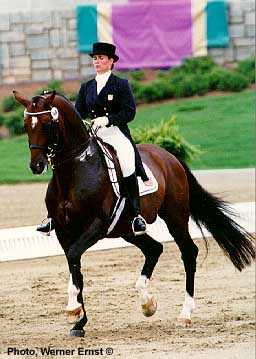
Dressage

The three modern
Olympic equestrian sports are show-jumping, dressage and eventing.
Dressage developed from the high-school equitation of the 15th to 18th centuries
which was popular in the royal courts of Europe. Movements that had
originally been developed for use in battle were combined into a demonstration
of horsemanship that showed off the stamina, agility and obedience of the horse
and the skills of the rider.
________________________________________________________________________________________
America was slow to take up the art of dressage (a word that means training
in French). The French and Germans developed this highly refined technique
of equine calisthenics for horse and rider, and the supreme demonstration of
dressage remains that of the famous Spanish Riding School of Vienna, with its
magnificent Lipizzan
horses. The object of the exercises of dressage is to
give a horse balance, great muscular flexibility, and perfect response to the
most subtle commands of an accomplished rider. Entrants put their mounts
through a series of drills over a flat course. Commands to the horse must
not be perceptible to viewers.
________________________________________________________________________________________
The fundamental purpose of dressage (a French term meaning "training")
is to develop, through standardized progressive training methods, a horse's
natural athletic ability and willingness to perform, thereby maximizing its
potential as a riding horse.
Although the discipline has its roots in classical Greek
horsemanship, dressage was first recognized as an important equestrian pursuit
during the Renaissance in western Europe.
The great European riding masters of that period developed a
sequential training system that has changed little since then and is still
considered the basis of modern dressage.
Early European aristocrats displayed their horses' training
in equestrian pageants, but in modern dressage competition, successful training
at the various levels is demonstrated through the performance of
"tests," or prescribed series of movements within a standard arena.
Judges evaluate each movement on the basis of an objective
standard appropriate to the level of the test and assign each movement a score
from 0 to 10 -- zero being "not executed" and 10 being
"excellent." A score of 9 (or "very good") is
considered a particularly high mark.